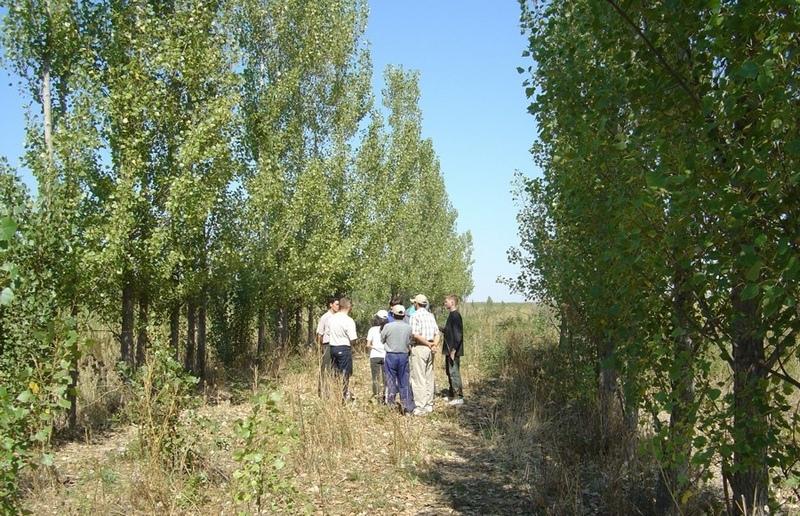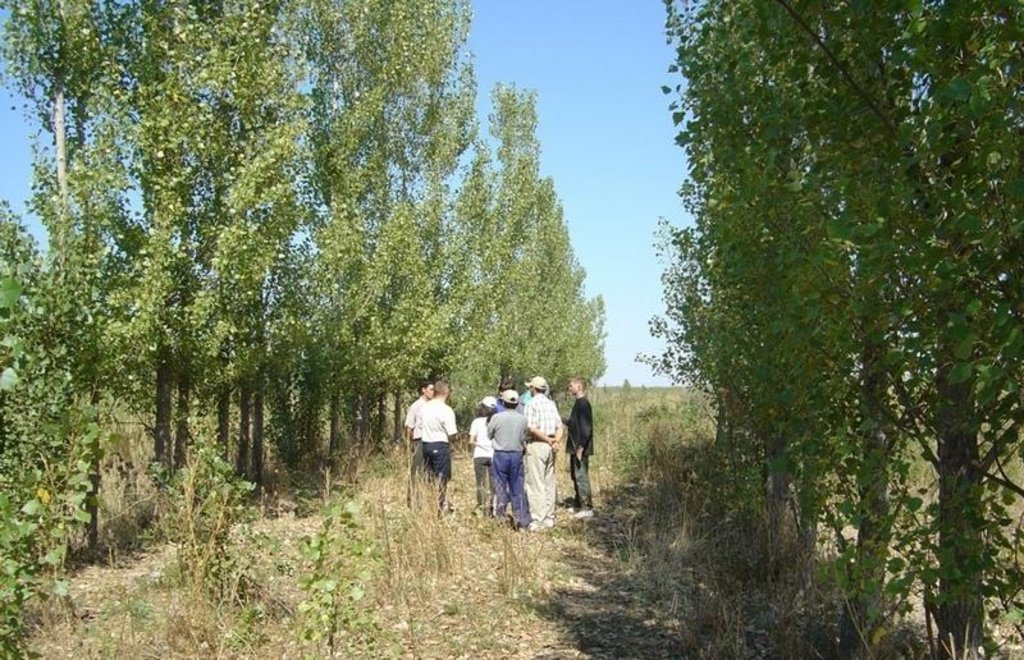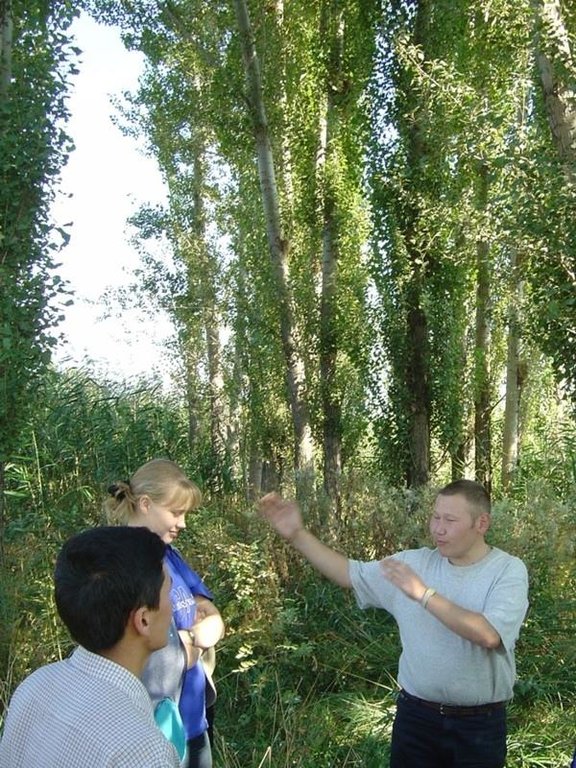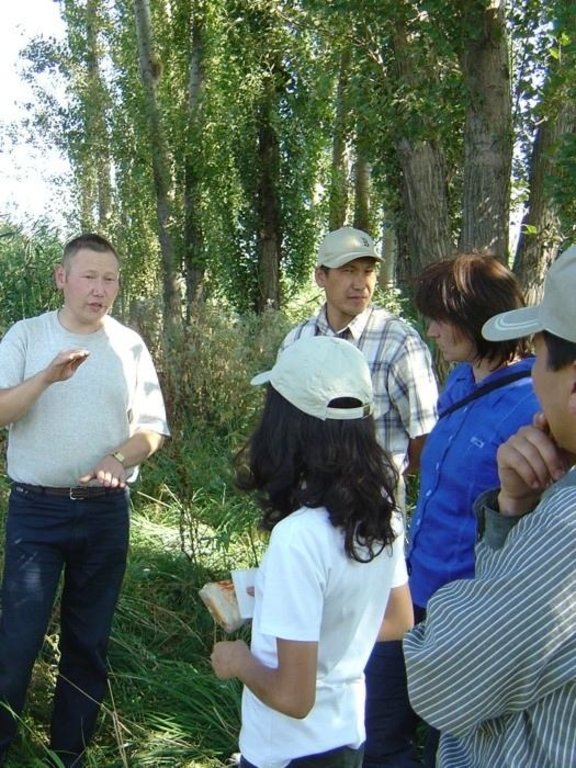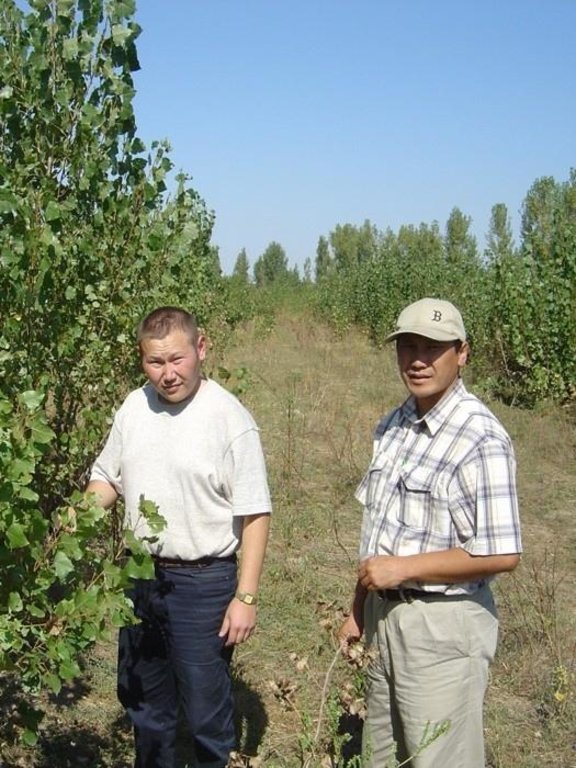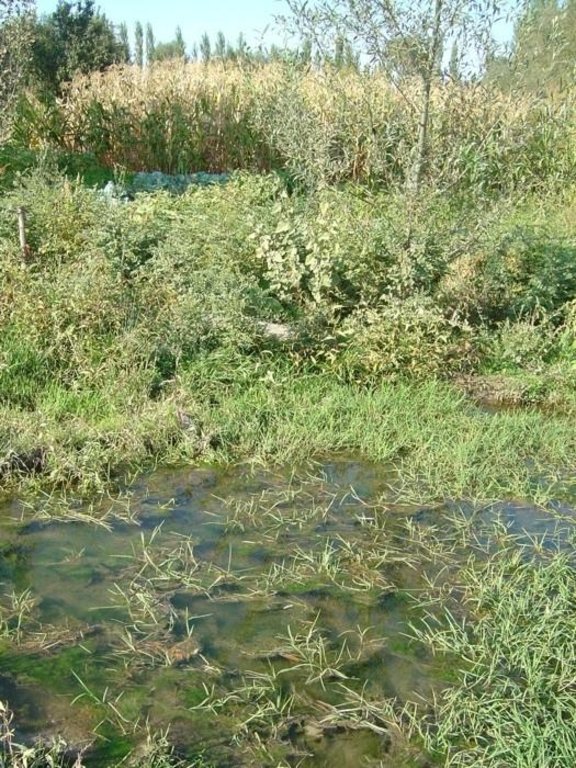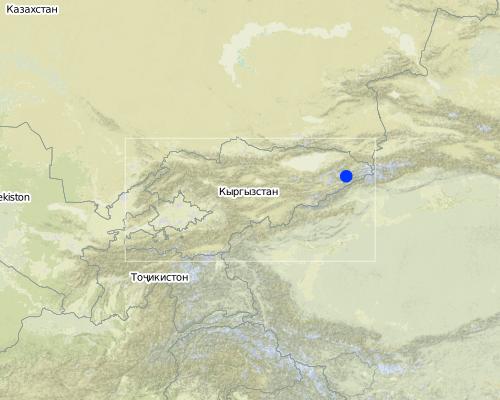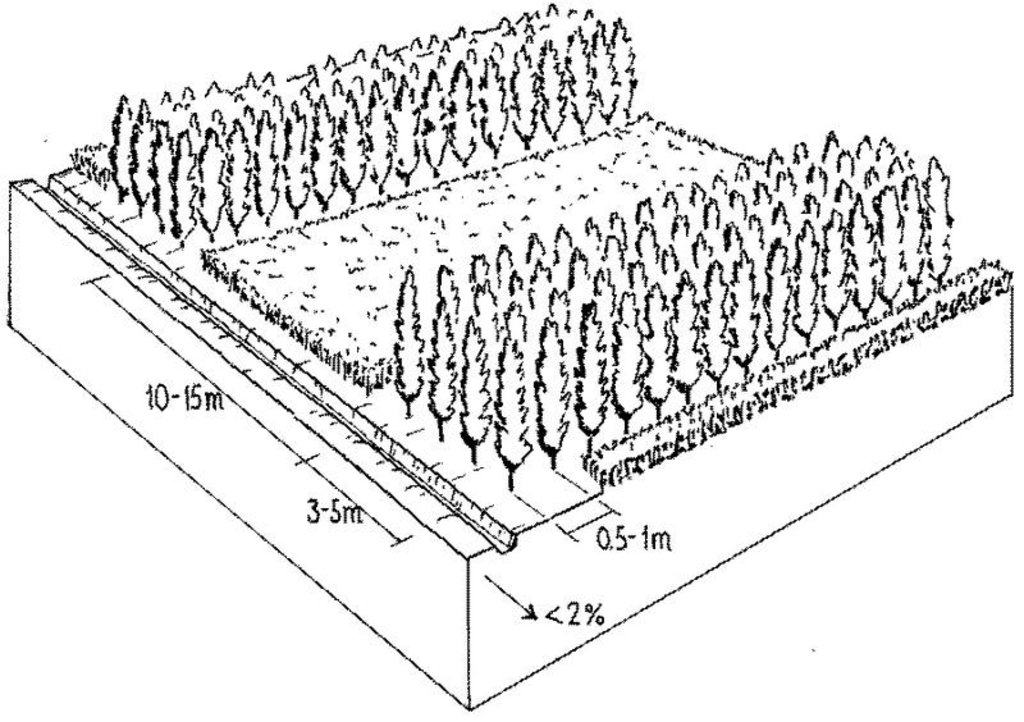Poplar trees for bio-drainage [Kyrgyzstan]
- Creation:
- Update:
- Compiler: Abdybek Asanaliev
- Editor: –
- Reviewer: David Streiff
bio-drainage, reduce salinity, favourable microclimate for for plant growth
technologies_1098 - Kyrgyzstan
View sections
Expand all Collapse all1. General information
1.2 Contact details of resource persons and institutions involved in the assessment and documentation of the Technology
SLM specialist:
Name of the institution(s) which facilitated the documentation/ evaluation of the Technology (if relevant)
Kyrgyz Agrarian University (Kyrgyz Agrarian University) - Kyrgyzstan1.3 Conditions regarding the use of data documented through WOCAT
When were the data compiled (in the field)?
01/01/2004
The compiler and key resource person(s) accept the conditions regarding the use of data documented through WOCAT:
Yes
2. Description of the SLM Technology
2.1 Short description of the Technology
Definition of the Technology:
Poplars planted to lower the ground water table and reduce salinity
where irrigation drainage systems have broken down; lucerne cultivated between the tree lines.
2.2 Detailed description of the Technology
Description:
In irrigated areas of Central Asia, the drainage system introduced during soviet times has broken down due to lack of maintenance. As a result, water tables have been rising and soil salinity increasing. In the Chui Valley, which is the main crop production area in Kyrgyzstan, approximately 90% of the cultivated land is irrigated for wheat, maize, sugar beet, lucerne and vegetables. Of this, approximately one third (ca. 320,000 ha) is degraded due to loss of fertility, salinisation and waterlogging.
The individual initiative described here - poplar planting - has been applied on a degraded plain (about 400 m a.s.l.), under semi-arid conditions on a plot of 5 hectares. Though initially planted for timber, an important side effect was noted by the farmer in question. Poplar trees, well known for their tolerance to waterlogging and salinity, provide ‘bio-drainage’. Excess water is rapidly taken up by the root system and transpired through the dense foliage. Within the plantation the humidity level of the lower layers of air is increased, thus reducing the influence of the dry, hot winds. A more favourable microclimate for plant growth is thus created. Simultaneously the original purpose of planting - to obtain cheap timber and firewood - is achieved through the rapid growth of the trees: there is a severe shortage of wood locally.
The varieties used include the local Populus alba and Populus nigra as well as a hybrid from Kazakhstan, P. pyramidalis. The trees are planted in rows about 5 metres wide, separated by 10-15 metre strips planted with Medicago sativa (lucerne) and Bromus inermis (a grass), both of which are grown for hay (see technical drawing). Around 3,000 saplings are needed per hectare. The young poplars require irrigating during the first year before their roots can reach the water table. The trees are weeded and their lower branches pruned to encourage straight and fast growth. They are thinned twice before they are 14 years old: these thinnings can be sold. The poplars then remain until they are 20-25 years old and suitable for felling. The output of commercial timber of a poplar plantation is 3,000 m2 per hectare (1 m2 per mature tree). Slow-growing/sick trees, as well as pruned branches, are used as firewood - which can amount to 20-30 m3 per hectare. The cycle begins again after approximately 10 years, when new saplings are planted between the existing, thinned, lines of poplars. Desalinisation of the soil takes 10 years or a little longer, when it again becomes suitable for irrigated cereal cropping.
2.3 Photos of the Technology
2.5 Country/ region/ locations where the Technology has been applied and which are covered by this assessment
Country:
Kyrgyzstan
Region/ State/ Province:
Besh-Terek, Chui valley,
Map
×2.7 Introduction of the Technology
Specify how the Technology was introduced:
- during experiments/ research
3. Classification of the SLM Technology
3.1 Main purpose(s) of the Technology
- reduce, prevent, restore land degradation
3.2 Current land use type(s) where the Technology is applied

Mixed (crops/ grazing/ trees), incl. agroforestry
- Agroforestry
Main products/ services:
major cash crop: Poplar
major food crop: Poplar, lucerne, wheat
Comments:
Major land use problems (compiler’s opinion): Irrigation drainage systems have deteriorated (silted up, choked with weeds and reeds) due to lack of maintenance. This has led to a raised water table, waterlogging and increased salinity, thus seriously affecting productivity and making cultivation of some crops impossible. Farmers’ incomes have significantly reduced as a result.
Constraints of wastelands / deserts / glaciers / swamps
3.3 Further information about land use
Number of growing seasons per year:
- 1
Specify:
Longest growing period in days: 180; Longest growing period from month to month: Mar - Sep
3.4 SLM group to which the Technology belongs
- forest plantation management
- improved ground/ vegetation cover
3.5 Spread of the Technology
Specify the spread of the Technology:
- evenly spread over an area
Comments:
Total area covered by the SLM Technology is 0.05 km2.
3.6 SLM measures comprising the Technology

agronomic measures
- A1: Vegetation/ soil cover

vegetative measures
- V1: Tree and shrub cover
Comments:
Type of agronomic measures: legume inter-planting
Type of vegetative measures: aligned: -against wind
3.7 Main types of land degradation addressed by the Technology

chemical soil deterioration
- Cn: fertility decline and reduced organic matter content (not caused by erosion)
- Cs: salinization/ alkalinization

physical soil deterioration
- Pw: waterlogging
Comments:
Secondary types of degradation addressed: Cn: fertility decline and reduced organic matter content
3.8 Prevention, reduction, or restoration of land degradation
Specify the goal of the Technology with regard to land degradation:
- restore/ rehabilitate severely degraded land
4. Technical specifications, implementation activities, inputs, and costs
4.1 Technical drawing of the Technology
4.2 Technical specifications/ explanations of technical drawing
Alternating strips of poplar trees for bio-drainage, and lucerne for fodder. Drainage channels (left) are spaced at 50 metres apart.
Technical knowledge required for field staff / advisors: moderate
Technical knowledge required for land users: moderate
Main technical functions: lower ground water level, decrease waterlogging & improve soil fertility, reduce risk of salinisation
Secondary technical functions: reduction in wind speed, increased air humidity & cooling effect
Aligned: -against wind
Vegetative material: T : trees / shrubs
Trees/ shrubs species: Poplars (Populus alba, Populus nigra, P.pyramidalis)
4.3 General information regarding the calculation of inputs and costs
Specify currency used for cost calculations:
- US Dollars
4.4 Establishment activities
| Activity | Type of measure | Timing | |
|---|---|---|---|
| 1. | Set up tree nursery one year before planting: take cuttings about | Vegetative | |
| 2. | Demarcate lines in field. | Vegetative | |
| 3. | Dig drainage trenches in the marshy area (50 cm deep, 50 cm wide, | Vegetative | (end of summer, early autumn) |
| 4. | Plough where seedlings of the poplars are to be planted. | Vegetative | |
| 5. | Transplant tree seedlings from the nursery to the field . | Vegetative | in spring |
| 6. | Irrigate the seedlings by furrow for one year. | Vegetative | |
| 7. | Protect the area from animals. | Vegetative | |
| 8. | Plant lucerne . | Vegetative | in first year after planting of poplars |
4.5 Costs and inputs needed for establishment
| Specify input | Unit | Quantity | Costs per Unit | Total costs per input | % of costs borne by land users | |
|---|---|---|---|---|---|---|
| Labour | All the Labour | ha | 1.0 | 350.0 | 350.0 | 100.0 |
| Labour | Machine use | ha | 1.0 | 100.0 | 100.0 | 100.0 |
| Labour | Animal traction | ha | 1.0 | 5.0 | 5.0 | 100.0 |
| Equipment | Tools | ha | 1.0 | 15.0 | 15.0 | |
| Plant material | Seeds | ha | 1.0 | 20.0 | 20.0 | 1.0 |
| Plant material | Seedlings | ha | 1.0 | 350.0 | 350.0 | 1.0 |
| Plant material | Nursery | ha | 1.0 | 80.0 | 80.0 | 1.0 |
| Total costs for establishment of the Technology | 920.0 | |||||
Comments:
Duration of establishment phase: 24 month(s)
4.6 Maintenance/ recurrent activities
| Activity | Type of measure | Timing/ frequency | |
|---|---|---|---|
| 1. | Prune lower branches of the trees to encourage tall and straight | Vegetative | |
| 2. | Continue protection of the plot (because of lucerne). | Vegetative | |
| 3. | Cut lucerne for hay . | Vegetative | /4 times per year |
| 4. | Weed control (main weeds are Chenopodium album, | Vegetative |
4.7 Costs and inputs needed for maintenance/ recurrent activities (per year)
| Specify input | Unit | Quantity | Costs per Unit | Total costs per input | % of costs borne by land users | |
|---|---|---|---|---|---|---|
| Labour | All the labour | ha | 1.0 | 25.0 | 25.0 | 100.0 |
| Equipment | Machine use | ha | 1.0 | 5.0 | 5.0 | 100.0 |
| Total costs for maintenance of the Technology | 30.0 | |||||
Comments:
Machinery/ tools: shovel, axe, saw
Labour for establishment and maintenance are provided by the farmer and his family. After 10–15 years trees are
thinned for timber and the cycle begins again – with reduced establishment costs: new saplings are planted between the
existing, thinned, lines of poplars. On two sides the plot is protected by a drainage ditch and a concrete canal protect the plot respectively. Furthermore, there is an agreement with the neighbours not to let the animals graze the lucerne. However after the last cut of lucerne animals are allowed to graze the plot.
5. Natural and human environment
5.1 Climate
Annual rainfall
- < 250 mm
- 251-500 mm
- 501-750 mm
- 751-1,000 mm
- 1,001-1,500 mm
- 1,501-2,000 mm
- 2,001-3,000 mm
- 3,001-4,000 mm
- > 4,000 mm
Agro-climatic zone
- semi-arid
5.2 Topography
Slopes on average:
- flat (0-2%)
- gentle (3-5%)
- moderate (6-10%)
- rolling (11-15%)
- hilly (16-30%)
- steep (31-60%)
- very steep (>60%)
Landforms:
- plateau/plains
- ridges
- mountain slopes
- hill slopes
- footslopes
- valley floors
Altitudinal zone:
- 0-100 m a.s.l.
- 101-500 m a.s.l.
- 501-1,000 m a.s.l.
- 1,001-1,500 m a.s.l.
- 1,501-2,000 m a.s.l.
- 2,001-2,500 m a.s.l.
- 2,501-3,000 m a.s.l.
- 3,001-4,000 m a.s.l.
- > 4,000 m a.s.l.
5.3 Soils
Soil depth on average:
- very shallow (0-20 cm)
- shallow (21-50 cm)
- moderately deep (51-80 cm)
- deep (81-120 cm)
- very deep (> 120 cm)
Soil texture (topsoil):
- medium (loamy, silty)
Topsoil organic matter:
- medium (1-3%)
If available, attach full soil description or specify the available information, e.g. soil type, soil PH/ acidity, Cation Exchange Capacity, nitrogen, salinity etc.
Soil fertility is very low - low
Soil drainage / infiltration is poor
5.6 Characteristics of land users applying the Technology
Market orientation of production system:
- subsistence (self-supply)
- commercial/ market
Off-farm income:
- 10-50% of all income
Indicate other relevant characteristics of the land users:
Off-farm income specification: this individual is an employee of the regional agricultural department and has a small business
Market orientation of production system: Thinned poplar saplings, timber and firewood from prunings for market
5.7 Average area of land owned or leased by land users applying the Technology
- < 0.5 ha
- 0.5-1 ha
- 1-2 ha
- 2-5 ha
- 5-15 ha
- 15-50 ha
- 50-100 ha
- 100-500 ha
- 500-1,000 ha
- 1,000-10,000 ha
- > 10,000 ha
5.8 Land ownership, land use rights, and water use rights
Land ownership:
- individual, titled
Land use rights:
- individual
6. Impacts and concluding statements
6.1 On-site impacts the Technology has shown
Socio-economic impacts
Production
fodder production
Comments/ specify:
Lucerne between tree lines
fodder quality
Comments/ specify:
Lucerne between tree lines
wood production
Income and costs
farm income
workload
Other socio-economic impacts
input contstraints
Comments/ specify:
Not all the farmers have enough resources for introduction of this technology (equipment,
main benefit
Comments/ specify:
However, short-term benefit from lucerne as fodder and from firewood through pruning
Socio-cultural impacts
SLM/ land degradation knowledge
Ecological impacts
Water cycle/ runoff
excess water drainage
Soil
soil moisture
Climate and disaster risk reduction
fire risk
wind velocity
Other ecological impacts
soil fertility
Comments/ specify:
Due to lucerne: 100–130 kg of N
biodiversity
6.2 Off-site impacts the Technology has shown
wind transported sediments
General drop of water table
6.4 Cost-benefit analysis
How do the benefits compare with the establishment costs (from land users’ perspective)?
Short-term returns:
negative
Long-term returns:
very positive
How do the benefits compare with the maintenance/ recurrent costs (from land users' perspective)?
Short-term returns:
positive
Long-term returns:
very positive
6.5 Adoption of the Technology
- single cases/ experimental
If available, quantify (no. of households and/ or area covered):
1 household
Of all those who have adopted the Technology, how many have did so spontaneously, i.e. without receiving any material incentives/ payments?
- 0-10%
Comments:
There is a little trend towards spontaneous adoption of the Technology
Comments on adoption trend: A single farmer has developed this technology. It should be possible to spread the technology among other farmers but financial support (eg interest-free credit) will need to be provided. A recent assessment has showed that there is growing interest in the system by farmers in the region. Additionally, in the lower Yanvan Valley of Tajikistan, a similar bio-drainage system has been described - using poplars and mulberry trees. In that situation wheat is planted in association with the trees.
6.7 Strengths/ advantages/ opportunities of the Technology
| Strengths/ advantages/ opportunities in the compiler’s or other key resource person’s view |
|---|
|
Positive ecological effect: salinity and area of marshy land can be reduced and waterlogged soils reclaimed How can they be sustained / enhanced? Awareness raising and training of farmers to show the effect of poplar trees on reduction of waterlogging and salinisation. |
|
Rapid benefit through the production of lucerne and grass. Long-term production of valuable firewood and timber (both are in short supply) How can they be sustained / enhanced? Show the economic benefits of additional lucerne production and timber and firewood; demonstrate marketing opportunities. |
6.8 Weaknesses/ disadvantages/ risks of the Technology and ways of overcoming them
| Weaknesses/ disadvantages/ risks in the compiler’s or other key resource person’s view | How can they be overcome? |
|---|---|
| The implementation of the technology is not possible for all land users due to input and labour constraints |
Financial support, better organisation/ share of equipment. |
| Major benefit from timber production comes only after 25 years |
Create awareness about additional short-term benefits, especially firewood and fodder, as well as the long-term effects and the sustainability of the system. |
|
Cannot be replicated by all farmers in the valley at the same density as the market for trees (timber, firewood) will be saturated, and trees can never completely take the place of irrigated food crops: nevertheless the benefits will extend to those growers through the drainage function of the poplars |
A new overall production system will have to be worked out for the region. |
|
The case reported here works in its current design because of its isolated ‘island effect’: if more farmer grew poplar, the same bio-drainage effect could be achieved over the whole valley at a lower density of trees per unit area, implying a larger proportion of cultivable land. |
7. References and links
7.2 References to available publications
Title, author, year, ISBN:
Budaychiev D (2002) The prospects for hybrid poplar forest plantations. Resolving problems and the strategy of reformingagrarian science. News of Kyrgyz Agrarian Academy Vol. 2, Issue 3, 4.1 Bishkek
Links and modules
Expand all Collapse allLinks
No links
Modules
No modules


